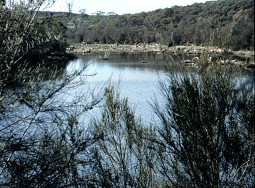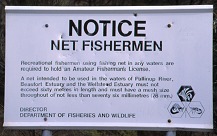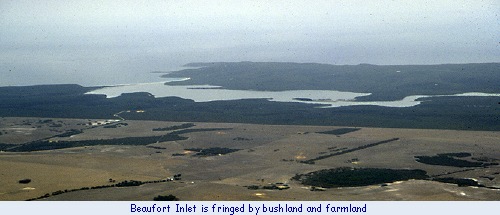I remember going down the river most probably a couple of days after that
rainfall event when the water had come down and it was like a very thin,
brown, liquidy chocolate. It really had a foul smell about it, almost like a
dirty old sheep dip or something like this. It was not very pleasant at all.
The vegetation along the river, down this end at any rate, I think has been
quite well preserved, well it's in the Pallinup Reserve. I think it's most
probably further upstream where things most need to be done."
Charlie Hick
"In the 70s we'd only catch what you needed, you didn't take more. I've
been down there after they've been with their nets and things and never
caught a thing. Sit there all day and never catch a thing. Normally you'd
throw your line in and sit ten minutes; fifteen minutes sometimes but you'd
have a fish. And that would go on all day long, you'd catch half a dozen or a
dozen and that was it. You could go on of course but you couldn't eat it all,
so you only took what you could eat."
Aden Eades
 "The last time I was there about three years ago and I was pretty disgusted. It really is degraded and I really don't know why because it's not as though there's a lot of people pressure there, I think it's probably fires more than anything. On the west side there were beautiful paperbarks and shady glens, it was really nice, but it looked quite horrid. I do know that the inlet itself too has silted up quite a lot from aerial photographs that I've seen and also from observation. Every time that we had a flood further up the river there seemed to be a noticeable burden of silt going into the river. We did take a boat down there on some occasions and you could boat around quite well. I'm quite sure now that lots of the parts of the inlet are so shallow that you wouldn't be able to boat."
"The last time I was there about three years ago and I was pretty disgusted. It really is degraded and I really don't know why because it's not as though there's a lot of people pressure there, I think it's probably fires more than anything. On the west side there were beautiful paperbarks and shady glens, it was really nice, but it looked quite horrid. I do know that the inlet itself too has silted up quite a lot from aerial photographs that I've seen and also from observation. Every time that we had a flood further up the river there seemed to be a noticeable burden of silt going into the river. We did take a boat down there on some occasions and you could boat around quite well. I'm quite sure now that lots of the parts of the inlet are so shallow that you wouldn't be able to boat."
Bill Moir
"We have many memories of it and they are really treasured memories because we will never see it again like that.
It's everybody's river and they abuse it in many ways. Of course the fishermen
have their turn, they are allowed to net for a couple of months and then
there's a gap and another fisherman's allowed to go, if it's worth going.
When they net they just empty rivers."
Brian Moir
 "Well I was fishing there all calm on a favourite rock of mine and I looked up all of a sudden and there across the river, on a little beach where a jut of land came in
and there was water behind it, was a naked man drying himself in the sunshine, or at least standing in the sunshine and getting dry. And that's when I decided it twern't my river any more.
It was after the war and every rock was spoilt with rubbish and litter, broken
glass, plastic, cans and things like this. Mother left me some land down
there that she had, a separate block, in her will but I sold it because it was
just rather revolting to go there because all the beauty had gone out of it."
"Well I was fishing there all calm on a favourite rock of mine and I looked up all of a sudden and there across the river, on a little beach where a jut of land came in
and there was water behind it, was a naked man drying himself in the sunshine, or at least standing in the sunshine and getting dry. And that's when I decided it twern't my river any more.
It was after the war and every rock was spoilt with rubbish and litter, broken
glass, plastic, cans and things like this. Mother left me some land down
there that she had, a separate block, in her will but I sold it because it was
just rather revolting to go there because all the beauty had gone out of it."
Betty Sewell
We didn't go to the estuary much anymore in those days (1970s) because
there was nothing much there. Well there were no birds to be seen in great
quantity. It changed, Corackerup changed as well, you could see the green
coming into it and the smell and it did change in those later years. There
always used to be quite a few musk ducks down on the point at Chillinup but
they seemed to disappear and the swans of course disappeared. There was
always swans breeding on the Pallinup, at the Point Pool mainly. When we
were doing the count I went down there one day and there was an abandoned
swans nest just off the bank and the eggs were there just thrown out of the
nest and left. There was always a pair breed up on the pool above the crossing
at Chillinup and when the cygnets were old enough mother would bring
them down as if to show us. She would cross across the crossing, the cement
and be very proud of herself. But that all stopped, they just didn't breed
there anymore, I presume it was because it was unsuitable. It became just
not suitable for breeding."
Ruth Moir
"But the Pallinup has taken a lot of hammering over the last twenty years
that I know of. The signs are there, the size nets you can use too. That's
just cleaning it out and of course with the different sized nets they take
everything, they're not really taking what they want. So it's important that
they do fish with the correct size net so that the smaller ones can escape to
keep stocks up. Most of them don't worry about that; they go down and get
what they can and what's no good they throw out. It's criminal really when
you consider that this river... we all have a connection to it and it's provided
not only for Noongar people but non-aboriginal people as well. A lot of
professional fishers used to fish there in the estuary part. But they just
don't police it enough. They really need to, and I've mentioned this to the
Fisheries and Waterways mob, they need to get a Noongar in there to police
these waters during the holiday seasons."
Aden Eades




